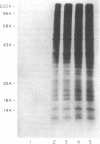Abstract
Two alloreactive human CD4+ T cell clones, recognizing HLA-DR2 and HLA-DR1 determinants, lost their specific proliferative capacity after infection with HIV. This system was used to explore the effect of polyI.polyC12U on HIV replication and immune suppression. The mismatched double-stranded RNA blocked HIV-associated particulate reverse transcriptase activity and viral-mediated cytopathic effects. Also, polyI.polyC12U preserved the alloreactivity of T cell clones after exposure to HIV.PolyI.polyC12U appeared to act at a level subsequent to host cell infection and reverse transcription. It had no effect on the enhancement of gene expression by the HIV transcription unit tatIII. These findings indicate that early in the course of infection of CD4+ T lymphocytes, HIV can directly abrogate proliferation to specific allodeterminants, and that this function is preserved in the presence of polyI.polyC12U. They also provide insight into the mechanism of antiviral action of a class of agent with potential clinical utility in AIDS.
Full text
PDF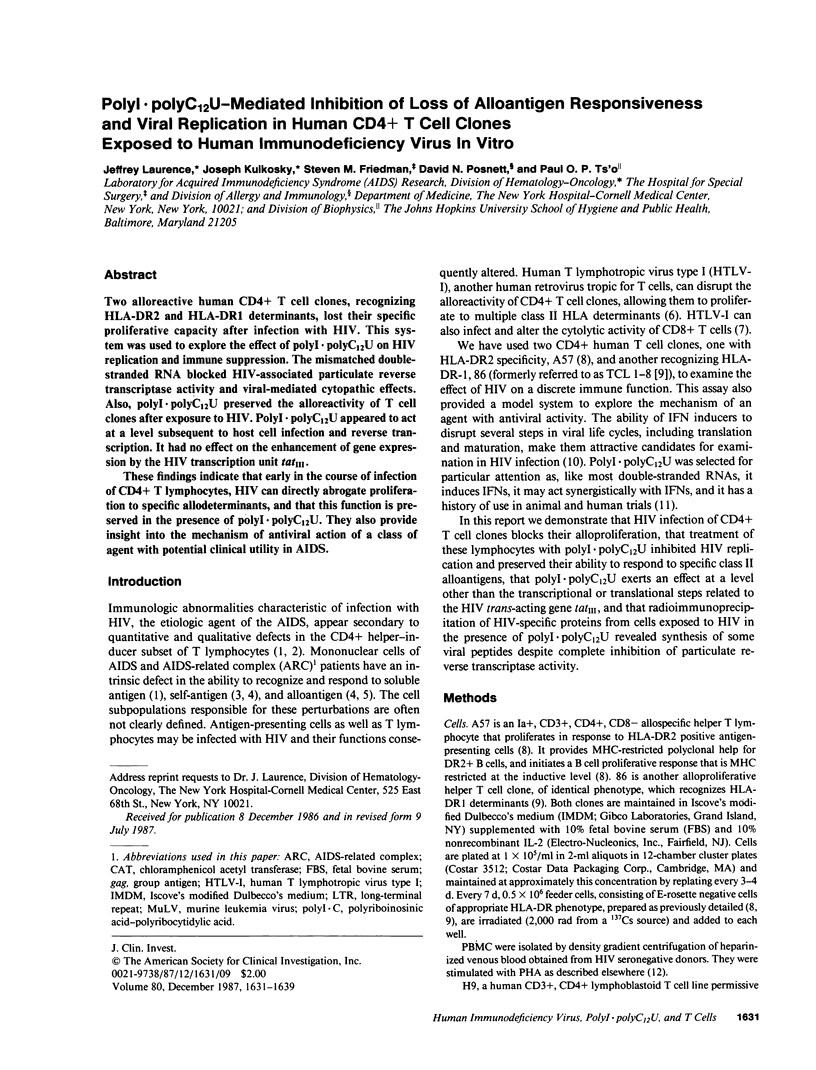
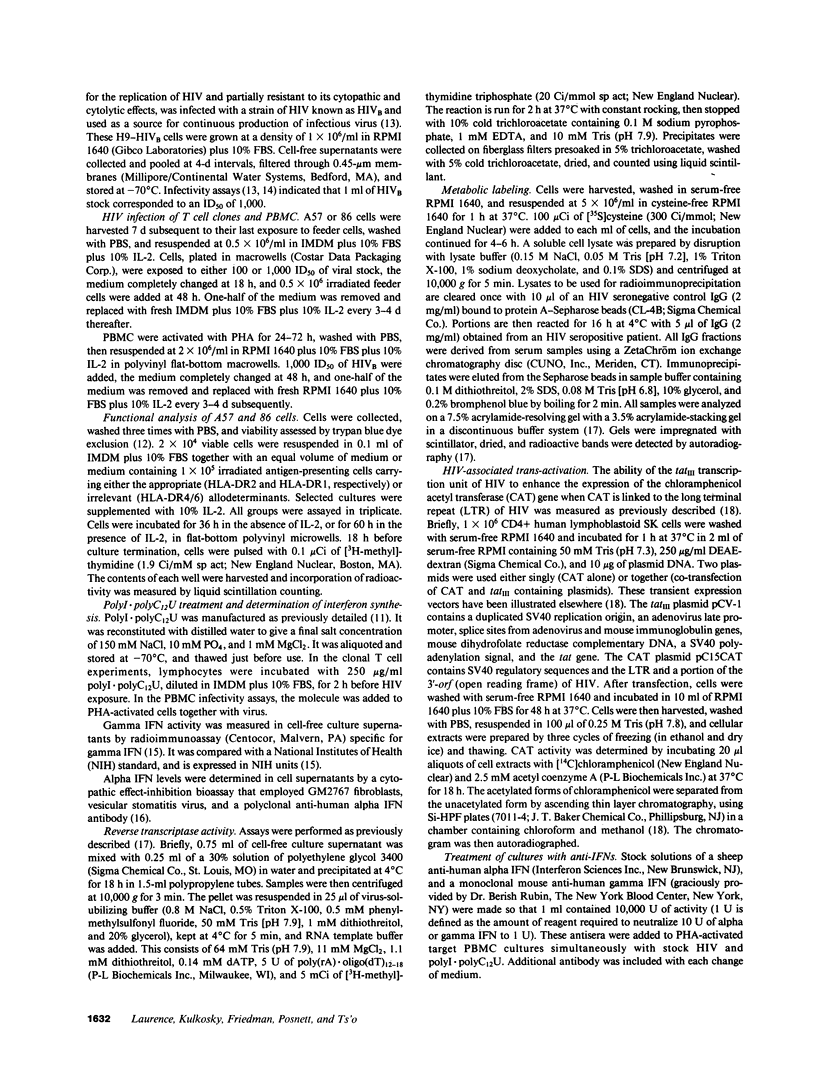
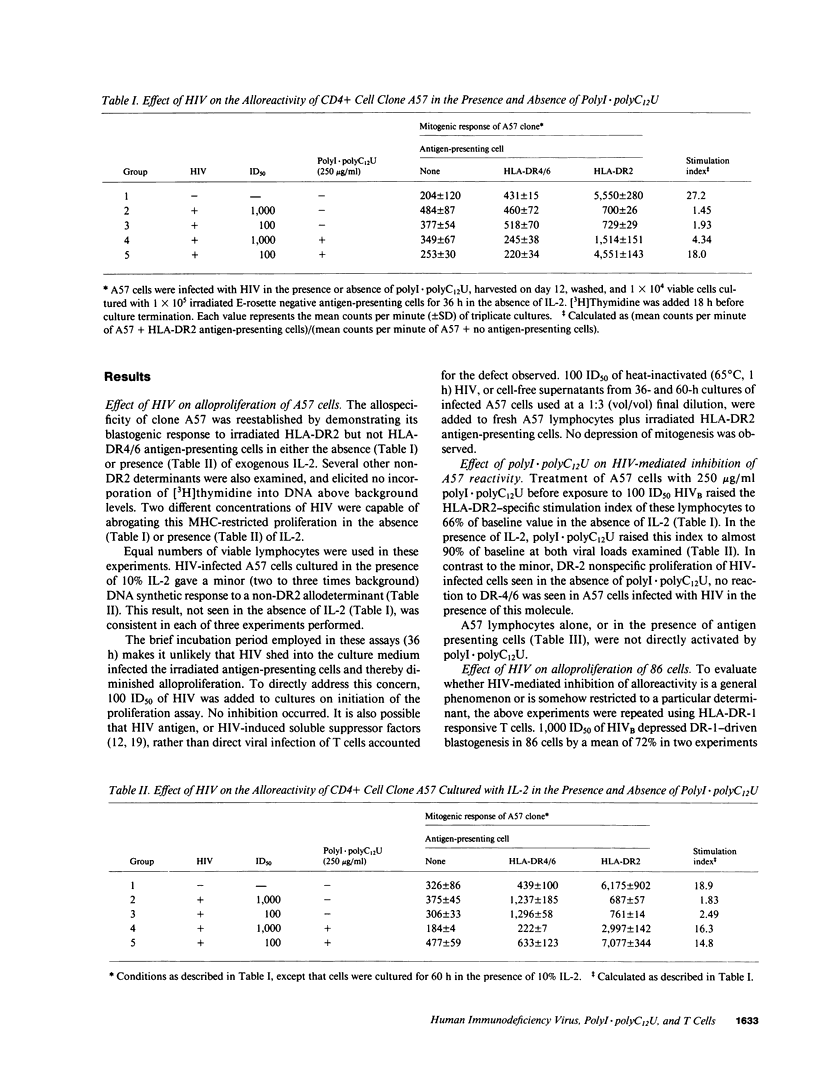
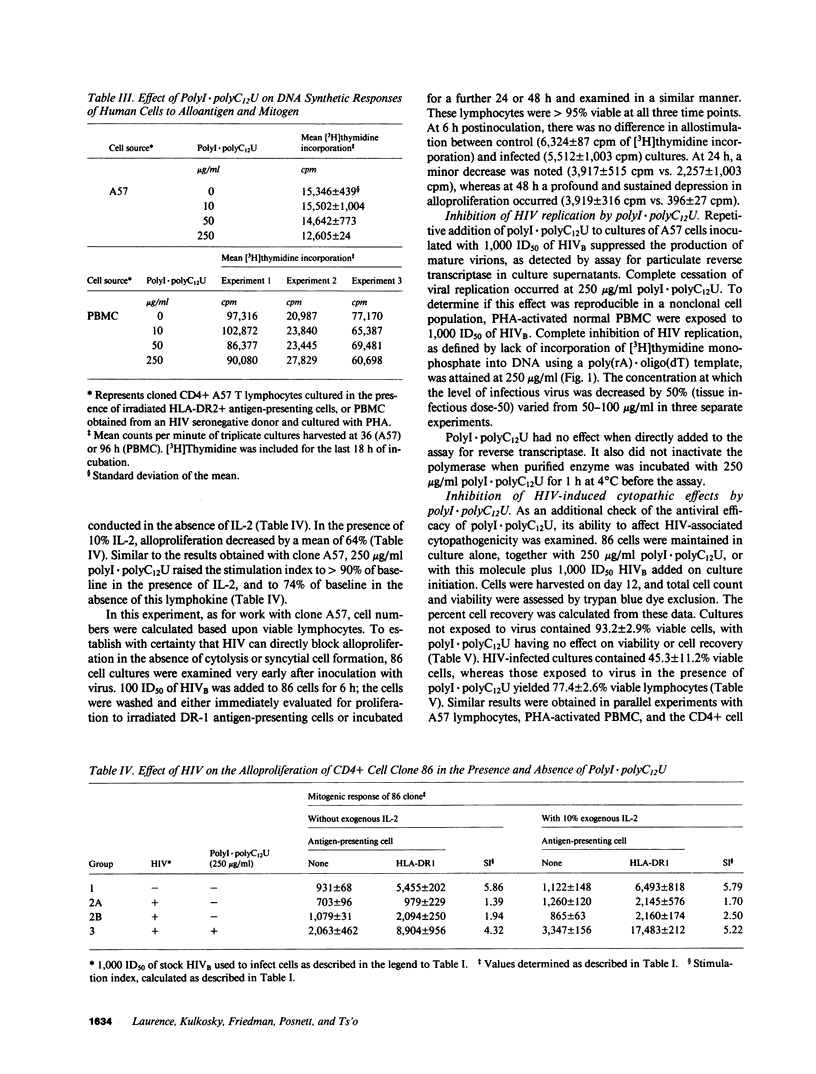
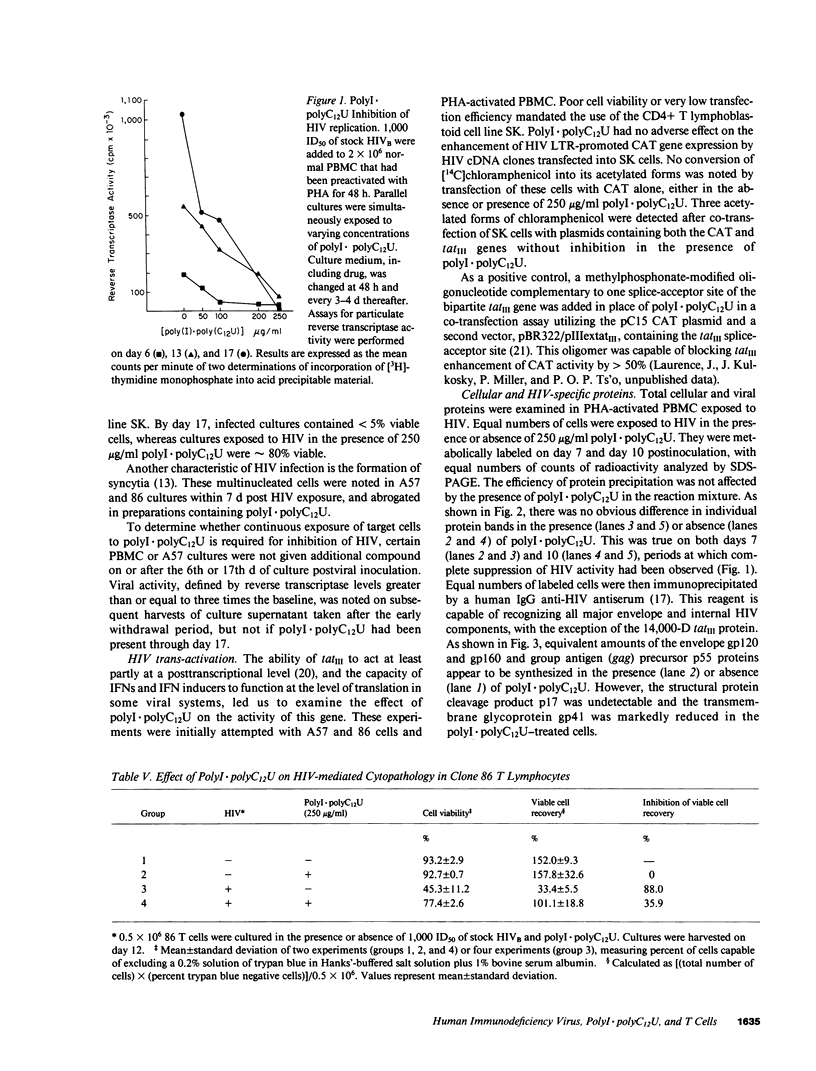
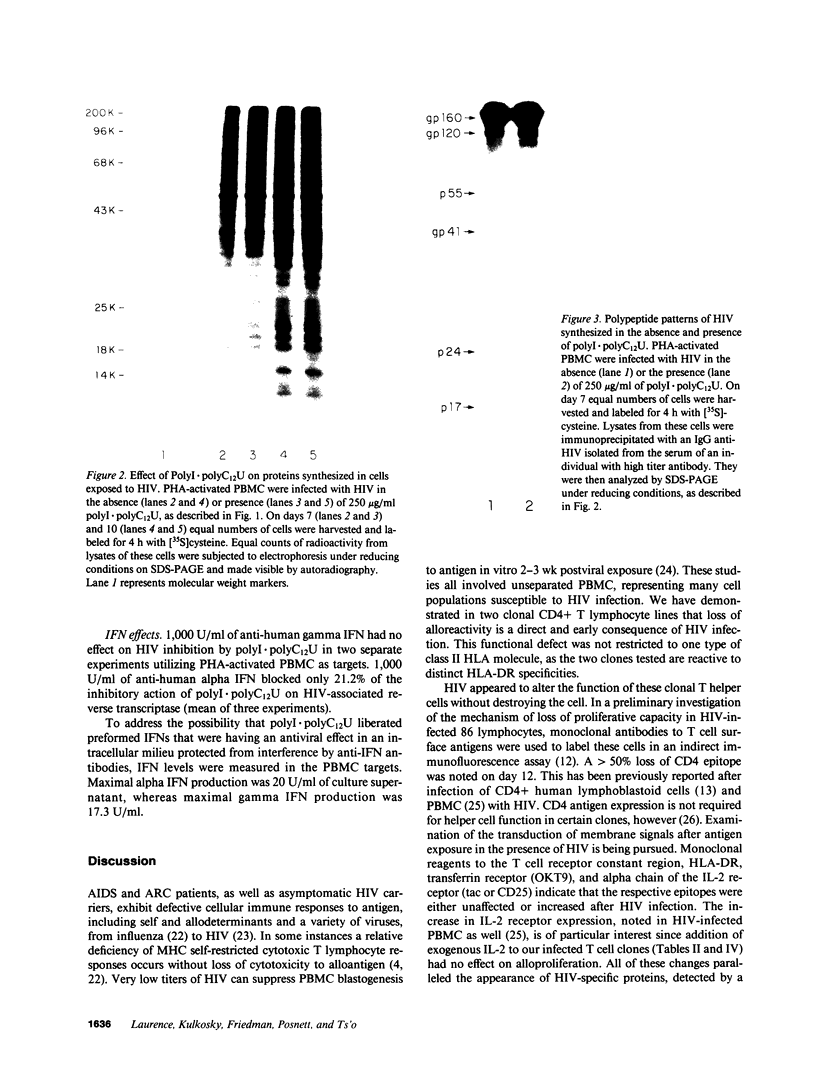
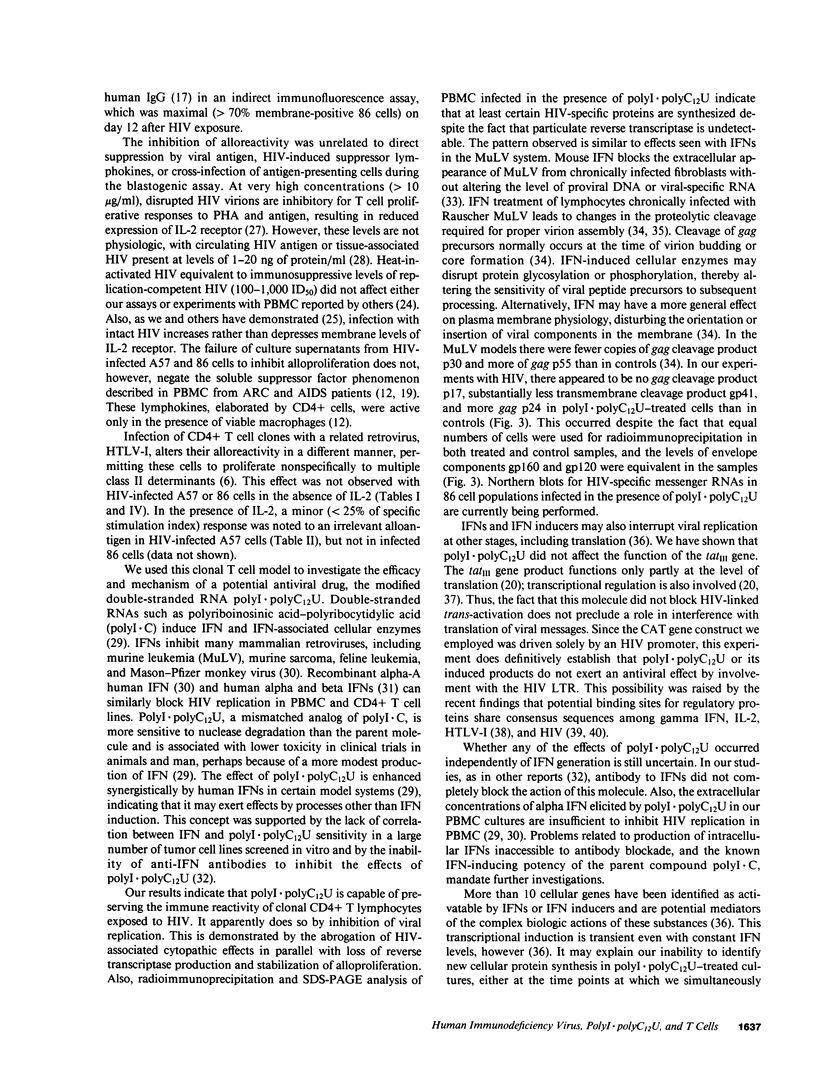
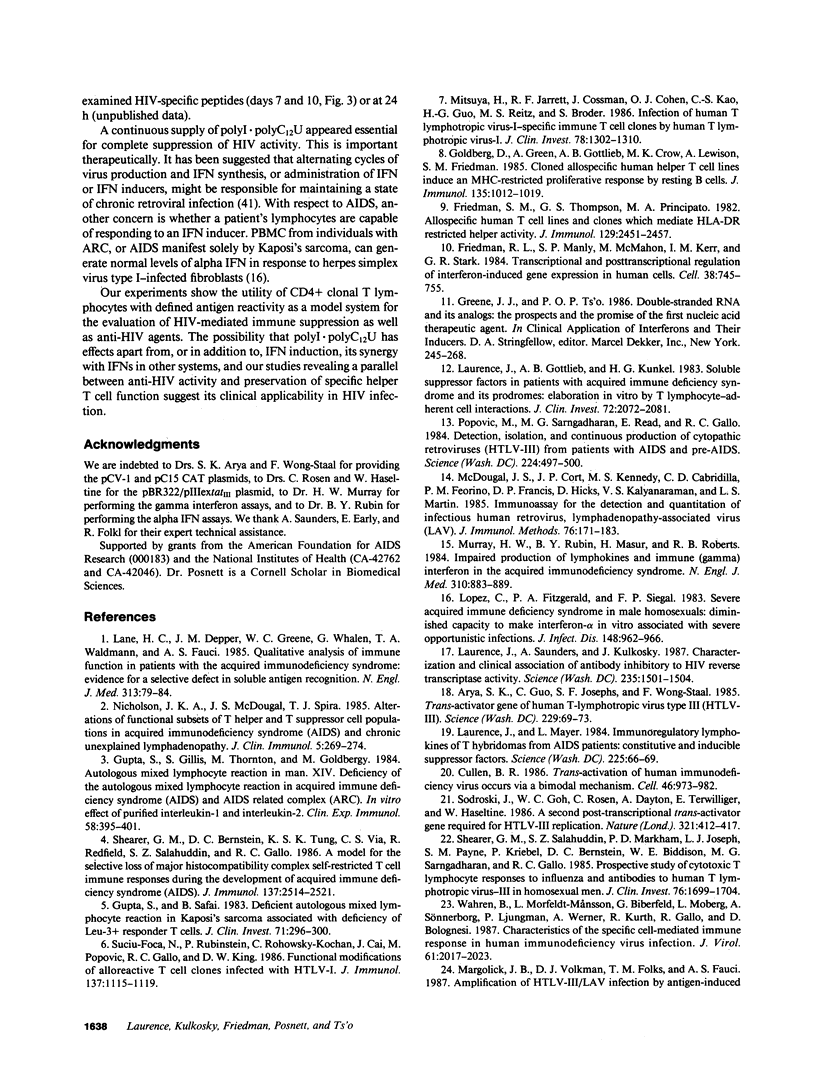
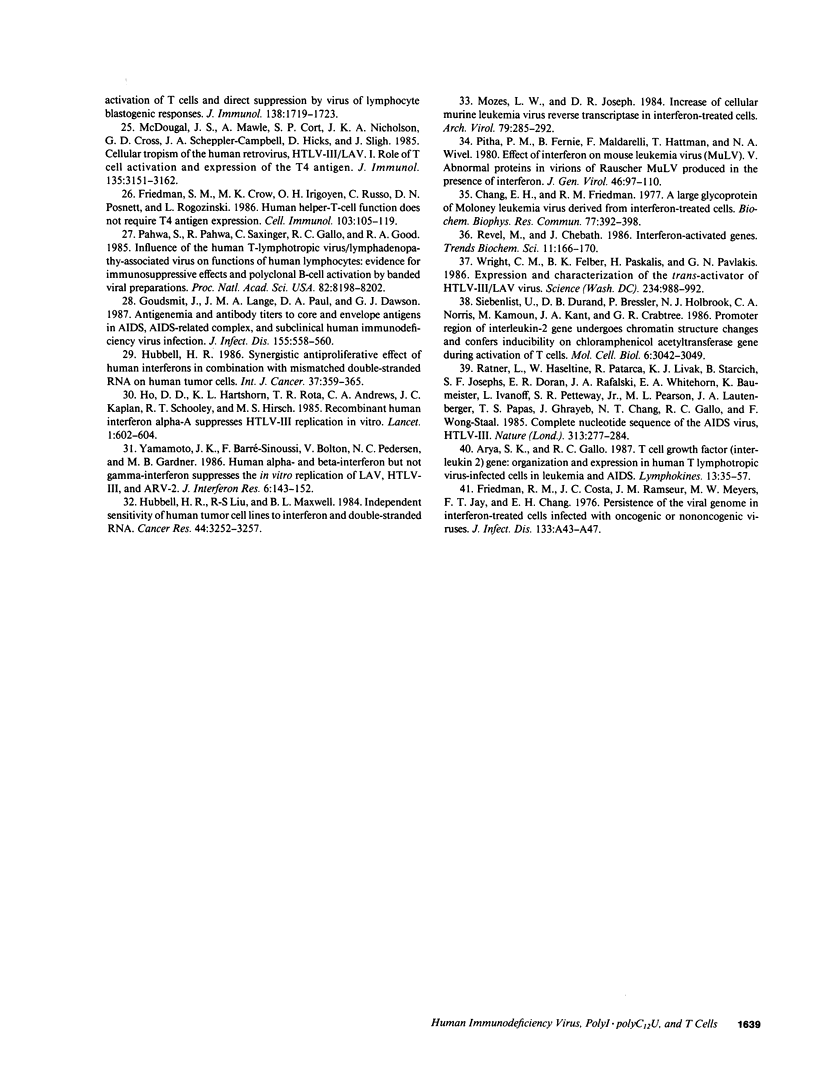
Images in this article
Selected References
These references are in PubMed. This may not be the complete list of references from this article.
- Arya S. K., Guo C., Josephs S. F., Wong-Staal F. Trans-activator gene of human T-lymphotropic virus type III (HTLV-III). Science. 1985 Jul 5;229(4708):69–73. doi: 10.1126/science.2990040. [DOI] [PubMed] [Google Scholar]
- Chang E. H., Friedman R. M. A large glycoprotein of Moloney leukemia virus derived from interferon-treated cells. Biochem Biophys Res Commun. 1977 Jul 11;77(1):392–398. doi: 10.1016/s0006-291x(77)80210-6. [DOI] [PubMed] [Google Scholar]
- Cullen B. R. Trans-activation of human immunodeficiency virus occurs via a bimodal mechanism. Cell. 1986 Sep 26;46(7):973–982. doi: 10.1016/0092-8674(86)90696-3. [DOI] [PubMed] [Google Scholar]
- Friedman R. L., Manly S. P., McMahon M., Kerr I. M., Stark G. R. Transcriptional and posttranscriptional regulation of interferon-induced gene expression in human cells. Cell. 1984 Oct;38(3):745–755. doi: 10.1016/0092-8674(84)90270-8. [DOI] [PubMed] [Google Scholar]
- Friedman R. M., Costa J. C., Ramseur J. M., Meyers M. W., Jay F. T., Chang E. H. Persistence of the viral genome in interferon-treated cells infected with oncogneic or nononcogenic viruses. J Infect Dis. 1976 Jun;133 (Suppl):A43–A50. doi: 10.1093/infdis/133.supplement_2.a43. [DOI] [PubMed] [Google Scholar]
- Friedman S. M., Crow M. K., Irigoyen O. H., Russo C., Posnett D. N., Rogozinski L. Human helper-T-cell function does not require T4 antigen expression. Cell Immunol. 1986 Nov;103(1):105–119. doi: 10.1016/0008-8749(86)90072-9. [DOI] [PubMed] [Google Scholar]
- Friedman S. M., Thompson G. S., Principato M. A. Allospecific human T cell lines and clones which mediate HLA-DR restricted helper activity. J Immunol. 1982 Dec;129(6):2451–2457. [PubMed] [Google Scholar]
- Goldberg D., Green A., Gottlieb A. B., Crow M. K., Lewison A., Friedman S. M. Cloned allospecific human helper T cell lines induce an MHC-restricted proliferative response by resting B cells. J Immunol. 1985 Aug;135(2):1012–1019. [PubMed] [Google Scholar]
- Goudsmit J., Lange J. M., Paul D. A., Dawson G. J. Antigenemia and antibody titers to core and envelope antigens in AIDS, AIDS-related complex, and subclinical human immunodeficiency virus infection. J Infect Dis. 1987 Mar;155(3):558–560. doi: 10.1093/infdis/155.3.558. [DOI] [PubMed] [Google Scholar]
- Gupta S., Gillis S., Thornton M., Goldberg M. Autologous mixed lymphocyte reaction in man. XIV. Deficiency of the autologous mixed lymphocyte reaction in acquired immune deficiency syndrome (AIDS) and AIDS related complex (ARC). In vitro effect of purified interleukin-1 and interleukin-2. Clin Exp Immunol. 1984 Nov;58(2):395–401. [PMC free article] [PubMed] [Google Scholar]
- Gupta S., Safai B. Deficient autologous mixed lymphocyte reaction in Kaposi's sarcoma associated with deficiency of Leu-3+ responder T cells. J Clin Invest. 1983 Feb;71(2):296–300. doi: 10.1172/JCI110769. [DOI] [PMC free article] [PubMed] [Google Scholar]
- Ho D. D., Hartshorn K. L., Rota T. R., Andrews C. A., Kaplan J. C., Schooley R. T., Hirsch M. S. Recombinant human interferon alfa-A suppresses HTLV-III replication in vitro. Lancet. 1985 Mar 16;1(8429):602–604. doi: 10.1016/s0140-6736(85)92144-0. [DOI] [PubMed] [Google Scholar]
- Hubbell H. R., Liu R. S., Maxwell B. L. Independent sensitivity of human tumor cell lines to interferon and double-stranded RNA. Cancer Res. 1984 Aug;44(8):3252–3257. [PubMed] [Google Scholar]
- Hubbell H. R. Synergistic antiproliferative effect of human interferons in combination with mismatched double-stranded RNA on human tumor cells. Int J Cancer. 1986 Mar 15;37(3):359–365. doi: 10.1002/ijc.2910370306. [DOI] [PubMed] [Google Scholar]
- Lane H. C., Depper J. M., Greene W. C., Whalen G., Waldmann T. A., Fauci A. S. Qualitative analysis of immune function in patients with the acquired immunodeficiency syndrome. Evidence for a selective defect in soluble antigen recognition. N Engl J Med. 1985 Jul 11;313(2):79–84. doi: 10.1056/NEJM198507113130204. [DOI] [PubMed] [Google Scholar]
- Laurence J., Gottlieb A. B., Kunkel H. G. Soluble suppressor factors in patients with acquired immune deficiency syndrome and its prodrome. Elaboration in vitro by T lymphocyte-adherent cell interactions. J Clin Invest. 1983 Dec;72(6):2072–2081. doi: 10.1172/JCI111172. [DOI] [PMC free article] [PubMed] [Google Scholar]
- Laurence J., Mayer L. Immunoregulatory lymphokines of T hybridomas from AIDS patients: constitutive and inducible suppressor factors. Science. 1984 Jul 6;225(4657):66–69. doi: 10.1126/science.6328662. [DOI] [PubMed] [Google Scholar]
- Laurence J., Saunders A., Kulkosky J. Characterization and clinical association of antibody inhibitory to HIV reverse transcriptase activity. Science. 1987 Mar 20;235(4795):1501–1504. doi: 10.1126/science.2435004. [DOI] [PubMed] [Google Scholar]
- Lopez C., Fitzgerald P. A., Siegal F. P. Severe acquired immune deficiency syndrome in male homosexuals: diminished capacity to make interferon-alpha in vitro associated with severe opportunistic infections. J Infect Dis. 1983 Dec;148(6):962–966. doi: 10.1093/infdis/148.6.962. [DOI] [PubMed] [Google Scholar]
- Margolick J. B., Volkman D. J., Folks T. M., Fauci A. S. Amplification of HTLV-III/LAV infection by antigen-induced activation of T cells and direct suppression by virus of lymphocyte blastogenic responses. J Immunol. 1987 Mar 15;138(6):1719–1723. [PubMed] [Google Scholar]
- McDougal J. S., Cort S. P., Kennedy M. S., Cabridilla C. D., Feorino P. M., Francis D. P., Hicks D., Kalyanaraman V. S., Martin L. S. Immunoassay for the detection and quantitation of infectious human retrovirus, lymphadenopathy-associated virus (LAV). J Immunol Methods. 1985 Jan 21;76(1):171–183. doi: 10.1016/0022-1759(85)90489-2. [DOI] [PubMed] [Google Scholar]
- McDougal J. S., Mawle A., Cort S. P., Nicholson J. K., Cross G. D., Scheppler-Campbell J. A., Hicks D., Sligh J. Cellular tropism of the human retrovirus HTLV-III/LAV. I. Role of T cell activation and expression of the T4 antigen. J Immunol. 1985 Nov;135(5):3151–3162. [PubMed] [Google Scholar]
- Mitsuya H., Jarrett R. F., Cossman J., Cohen O. J., Kao C. S., Guo H. G., Reitz M. S., Broder S. Infection of human T lymphotropic virus-I-specific immune T cell clones by human T lymphotropic virus-I. J Clin Invest. 1986 Nov;78(5):1302–1310. doi: 10.1172/JCI112715. [DOI] [PMC free article] [PubMed] [Google Scholar]
- Mozes L. W., Joseph D. R. Increase of cellular murine leukemia virus reverse transcriptase in interferon-treated cells. Arch Virol. 1984;79(3-4):285–292. doi: 10.1007/BF01310817. [DOI] [PubMed] [Google Scholar]
- Murray H. W., Rubin B. Y., Masur H., Roberts R. B. Impaired production of lymphokines and immune (gamma) interferon in the acquired immunodeficiency syndrome. N Engl J Med. 1984 Apr 5;310(14):883–889. doi: 10.1056/NEJM198404053101404. [DOI] [PubMed] [Google Scholar]
- Nicholson J. K., McDougal J. S., Spira T. J. Alterations of functional subsets of T helper and T suppressor cell populations in acquired immunodeficiency syndrome (AIDS) and chronic unexplained lymphadenopathy. J Clin Immunol. 1985 Jul;5(4):269–274. doi: 10.1007/BF00929462. [DOI] [PubMed] [Google Scholar]
- Pahwa S., Pahwa R., Saxinger C., Gallo R. C., Good R. A. Influence of the human T-lymphotropic virus/lymphadenopathy-associated virus on functions of human lymphocytes: evidence for immunosuppressive effects and polyclonal B-cell activation by banded viral preparations. Proc Natl Acad Sci U S A. 1985 Dec;82(23):8198–8202. doi: 10.1073/pnas.82.23.8198. [DOI] [PMC free article] [PubMed] [Google Scholar]
- Pitha P. M., Fernie B., Maldarelli F., Hattman T., Wivel N. A. Effect of interferon on mouse leukaemia virus (MuLV). V. Abnormal proteins in virions of Rauscher MuLV produced in the presence of interferon. J Gen Virol. 1980 Jan;46(1):97–110. doi: 10.1099/0022-1317-46-1-97. [DOI] [PubMed] [Google Scholar]
- Popovic M., Sarngadharan M. G., Read E., Gallo R. C. Detection, isolation, and continuous production of cytopathic retroviruses (HTLV-III) from patients with AIDS and pre-AIDS. Science. 1984 May 4;224(4648):497–500. doi: 10.1126/science.6200935. [DOI] [PubMed] [Google Scholar]
- Shearer G. M., Bernstein D. C., Tung K. S., Via C. S., Redfield R., Salahuddin S. Z., Gallo R. C. A model for the selective loss of major histocompatibility complex self-restricted T cell immune responses during the development of acquired immune deficiency syndrome (AIDS). J Immunol. 1986 Oct 15;137(8):2514–2521. [PubMed] [Google Scholar]
- Shearer G. M., Salahuddin S. Z., Markham P. D., Joseph L. J., Payne S. M., Kriebel P., Bernstein D. C., Biddison W. E., Sarngadharan M. G., Gallo R. C. Prospective study of cytotoxic T lymphocyte responses to influenza and antibodies to human T lymphotropic virus-III in homosexual men. Selective loss of an influenza-specific, human leukocyte antigen-restricted cytotoxic T lymphocyte response in human T lymphotropic virus-III positive individuals with symptoms of acquired immunodeficiency syndrome and in a patient with acquired immunodeficiency syndrome. J Clin Invest. 1985 Oct;76(4):1699–1704. doi: 10.1172/JCI112158. [DOI] [PMC free article] [PubMed] [Google Scholar]
- Siebenlist U., Durand D. B., Bressler P., Holbrook N. J., Norris C. A., Kamoun M., Kant J. A., Crabtree G. R. Promoter region of interleukin-2 gene undergoes chromatin structure changes and confers inducibility on chloramphenicol acetyltransferase gene during activation of T cells. Mol Cell Biol. 1986 Sep;6(9):3042–3049. doi: 10.1128/mcb.6.9.3042. [DOI] [PMC free article] [PubMed] [Google Scholar]
- Sodroski J., Goh W. C., Rosen C., Dayton A., Terwilliger E., Haseltine W. A second post-transcriptional trans-activator gene required for HTLV-III replication. Nature. 1986 May 22;321(6068):412–417. doi: 10.1038/321412a0. [DOI] [PubMed] [Google Scholar]
- Suciu-Foca N., Rubinstein P., Rohowsky-Kochan C., Cai J., Popovic M., Gallo R. C., King D. W. Functional modifications of alloreactive T cell clones infected with HTLV-I. J Immunol. 1986 Aug 15;137(4):1115–1119. [PubMed] [Google Scholar]
- Wahren B., Morfeldt-Månsson L., Biberfeld G., Moberg L., Sönnerborg A., Ljungman P., Werner A., Kurth R., Gallo R., Bolognesi D. Characteristics of the specific cell-mediated immune response in human immunodeficiency virus infection. J Virol. 1987 Jun;61(6):2017–2023. doi: 10.1128/jvi.61.6.2017-2023.1987. [DOI] [PMC free article] [PubMed] [Google Scholar]
- Wright C. M., Felber B. K., Paskalis H., Pavlakis G. N. Expression and characterization of the trans-activator of HTLV-III/LAV virus. Science. 1986 Nov 21;234(4779):988–992. doi: 10.1126/science.3490693. [DOI] [PubMed] [Google Scholar]
- Yamamoto J. K., Barré-Sinoussi F., Bolton V., Pedersen N. C., Gardner M. B. Human alpha- and beta-interferon but not gamma- suppress the in vitro replication of LAV, HTLV-III, and ARV-2. J Interferon Res. 1986 Apr;6(2):143–152. doi: 10.1089/jir.1986.6.143. [DOI] [PubMed] [Google Scholar]



